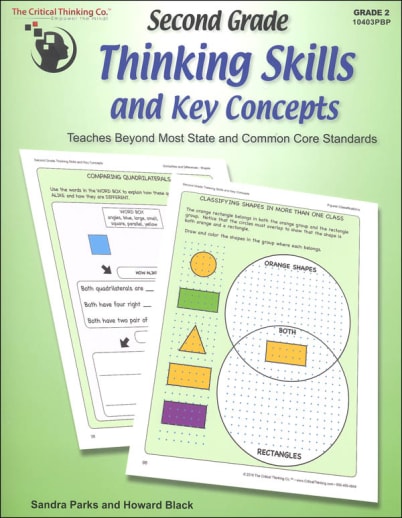Thinking Skills & Key Concepts Grade 2 helps children develop essential thinking skills and academic vocabulary while reinforcing key concepts in mathematics, social studies, and science. Students will describe and classify geometric shapes, learn about matter, water, weather, land/landforms, living and non-living things, as well as communities and our country (US). The Student Book concludes with a brief section on analogies. Consumable and colorful, the Student Workbook is not reproducible. The Thinking Skills & Key Concepts Grade 2 Teacher Manual is highly suggested for the interactive lessons. Alternatively, families familiar with the series may choose to use the PDF Answer Key which is available on the publisher’s website.
Second Grade Thinking Skills & Key Concepts Student Book
Product Overview
- Lessons are student-teacher interactive, and will take 20-30 minutes
- Observation skills, vocabulary, spatial thinking and verbal thinking skills are the focus
- Colorful and consumable, minimal information is included. Detailed instruction for teaching the lessons is found in the Teacher Manual (available separately)
Description
This highly-effective, standards-based, 160-page book is a research-based instructional program that teaches beyond most state and Common Core standards by:
- Improving children's observation and description skills
- Developing academic vocabulary
- Developing thinking skills that underlie content learning (describing/defining, identifying similarities and differences, sequencing, and classifying)
- Improving students' understanding of key concepts in mathematics, social studies, and science
- Students completing structured exercises to write sentences and paragraphs
- Carefully sequencing lessons to develop thinking skills
- Employing language integration techniques to teach thinking skills and key concepts
Academic Vocabulary Development
The program builds academic vocabulary using these important concepts: describe, compare and contrast, and classify shapes, position, patterns, matter, water, weather, land forms, bodies of water living and non-living things, communities, our country.
Observation Skills
Observation lessons involve concrete examples using detailed photographs to develop observation skills. The student book provides activities that students may use to clarify their thinking and learning by peer and class discussion.
Spatial Thinking Skills
" Describing Shapes - naming shapes, finding shapes to match a description, describing characteristics of a shape
" Similarities and Differences - matching and combining shapes, producing equal figures, figure completion
" Sequences - recognizing and producing the next figure in a sequence
" Classification - classifying by shape and/or color, forming classes, depicting overlapping classes
" Using positional and directional words
Verbal Thinking Skills
" Describing - matching a picture to a description, describing people, animals, or objects shown in pictures, part/whole analysis
" Similarities and Differences - selecting similar people, animals, or objects, explaining similarities and differences
" Sequences - ranking objects or people by a significant characteristic
" Classifications - explaining characteristics of a class, exceptions, sorting into classes
" Analogies - naming the kind of analogy or completing the analogy
Mental Models
This book teaches the characteristics outlined in its mental models needed to describe or define a concept.
How We Know It Works
" Increased scores on language proficiency and cognitive abilities tests
" Increased scores on normed or criterion-referenced achievement tests
" Proficient student writing
" Increased number of students placed in advanced classes and subsequent successful performance
The Thinking Skills & Key Concepts series from The Critical Thinking Company actually seems like an expansion of the popular Building Thinking Skills program. Incorporating all its excellent conceptual development and expanding beyond mathematics into science and social study applications, this series takes students beyond state standards. Designed to be a discussion-based curriculum, teacher-student interaction is vitally important and, in fact, the publishers warn against trying to administer the program by handing your student a workbook page.
Program goals include
clarifying and practicing various thinking skills (describe, compare/contrast,
sequencing, classification), developing the academic vocabulary needed to
describe key concepts in mathematics, science, and social studies, and to
promote clear conceptualization of key concepts even in the primary grades
knowing these will become more complex in later grades.
The consumable Student Books incorporate instructional methods such as teaching skills explicitly, using different learning styles for some teaching, responding in whole sentences, and applying the concept in new forms. The Teacher Manuals include reduced student pages with answers, introductory information for the course and each chapter, and more. This series is an excellent choice if you desire to make sure your student is prepared for higher order thinking in upper grades and for standardized testing.
| Product Format: | Paperback |
|---|---|
| Grade: | 2 |
| Brand: | Critical Thinking Company |
| ISBN: | 9781601448446 |
| Length in Inches: | 11 |
| Width in Inches: | 8.5 |
| Height in Inches: | 0.4375 |
| Weight in Pounds: | 1.2 |

